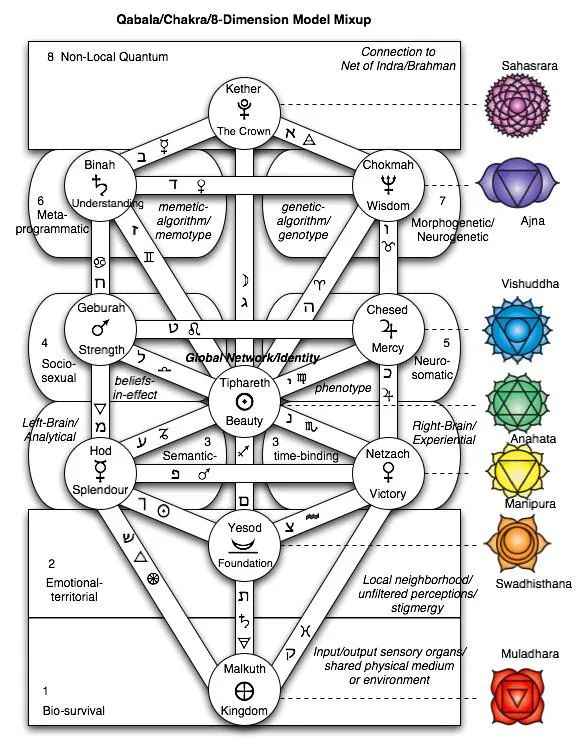Between Heaven and Earth: The Tree of Life, the Chakra System, and the Balance of the Heart
Across cultures, mystics have sketched hidden maps of the human being — ways to navigate the terrain between flesh and spirit. Two of the most enduring maps come from different worlds: the Kabbalistic Tree of Life from Jewish mystical tradition, and the chakra system from the yogic lineages of India.
At first glance, these maps might seem like mirrors held up to opposite impulses: one sanctifying the world through embodiment, the other urging the seeker to rise above it. But look closer, and you’ll find they share a deeper truth — that the human heart is the secret bridge between heaven and earth.
The Tree of Life: Divine Light Rooted in the World
In Kabbalah, the Tree of Life describes ten Sephirot — emanations of the Infinite. It is not a ladder to climb and then discard, but a living structure for how divine energy flows into the material world. The goal of the Kabbalist is not to abandon matter but to reveal its hidden light — to raise the sparks trapped in mundane things and return them to their source.
In this vision, the human body, relationships, daily work, and community are not obstacles to holiness but vessels for it. Even the most ordinary acts — eating, speaking, loving — can become sacred rituals. The divine is not far away in some distant heaven; it indwells the world.
This worldview gave rise to a culture that roots spirituality in tangible life. Jewish mysticism does not reject the physical but transforms it, aiming for tikkun olam — repairing the world — by embodying divine wisdom in every detail.
The Chakra System: Rising Beyond the Body
By contrast, the chakra system — most often seen through Hindu and yogic traditions — is an inner map of energy centers stacked along the spine. These centers reflect layers of consciousness, from the earthy foundation of survival and sexuality to the crown of pure cosmic unity.
The classic journey of kundalini is an upward current: the coiled serpent energy at the base of the spine awakens and ascends, piercing each chakra until it dissolves in the infinite. Here, the body is the starting point — but the destination is often described as beyond body and mind, beyond the illusion (maya) of the material world.
Indian culture, shaped by philosophies like Vedanta and Buddhism, has long held renunciation as a high ideal — freedom from the endless wheel of birth and death. This spiritual impulse values the formless over the formed, the timeless over the transient.

But There Are Always Exceptions
Of course, neither tradition is a single monolith. Within Judaism, ecstatic mystics have left the synagogue behind to wander forests and dance in holy rapture. And the radical vision of Hasidism reminds us that joy and embodied devotion are gates to the divine.
Likewise, Indian Tantra flips the usual script: here the body is not a trap to escape but a sacred playground. The senses become tools for awakening, the erotic a path to union with the Absolute. Even within yogic practice, some schools honor the heart chakra (Anahata) not merely as a stage to pass through but as a living center of spiritual maturity — the meeting point of above and below.
The Heart: Bridge and Balance
Between these two visions — sanctifying the world and transcending it — stands the human heart. On the Tree of Life, the sephirah Tiferet — beauty — sits at the center. It balances the polarities of mercy and judgment, spirit and matter, heaven and earth. In the chakra system, Anahata is likewise the mid-point, the green lotus that opens when the animal instincts below are reconciled with the higher intellect above.
When we live only for the material, we risk forgetting the vast sky of spirit. When we live only to transcend, we risk bypassing the beauty of incarnation — the dance of form. But in the heart, we remember both. We rise and we return. We root our wings in the soil. We let the divine breathe through flesh.
A Living Synthesis
In today’s world, many seekers intuitively weave these maps together. We use the chakras to feel where our energy is blocked or yearning to rise. We contemplate the Tree of Life to remember that divine light seeks embodiment — not escape. We meditate, we act. We dream, we build. We become bridges.
Between the roots and the crown, the heart waits: the quiet garden where transcendence kisses embodiment, and we remember that the true temple was always here — alive, breathing, human.
May we live from this heart — a Tree and a Serpent entwined — carrying heaven into earth, and earth into heaven.
